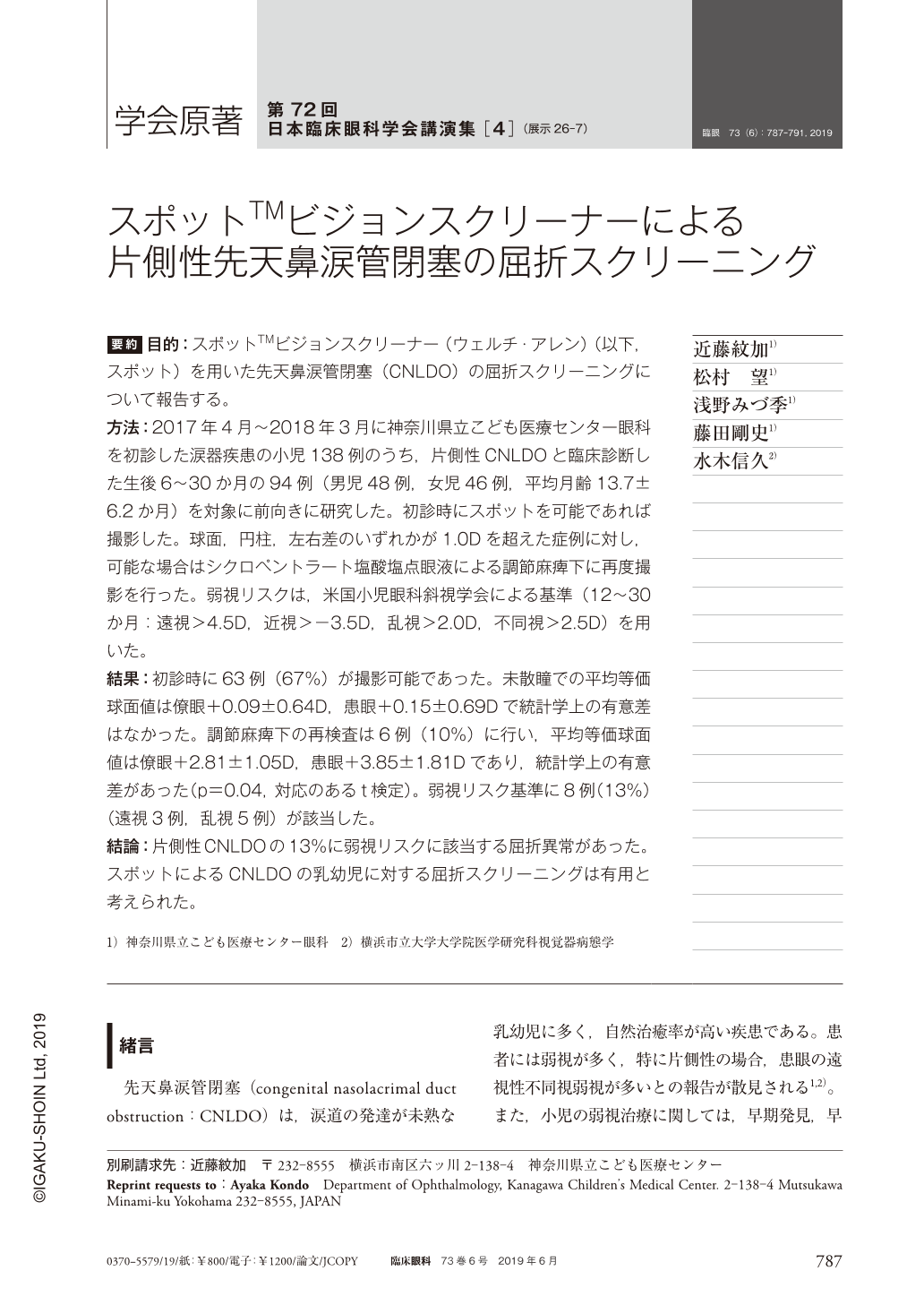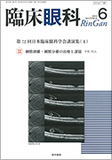Japanese
English
- 有料閲覧
- Abstract 文献概要
- 1ページ目 Look Inside
- 参考文献 Reference
要約 目的:スポットTMビジョンスクリーナー(ウェルチ・アレン)(以下,スポット)を用いた先天鼻涙管閉塞(CNLDO)の屈折スクリーニングについて報告する。
方法:2017年4月〜2018年3月に神奈川県立こども医療センター眼科を初診した涙器疾患の小児138例のうち,片側性CNLDOと臨床診断した生後6〜30か月の94例(男児48例,女児46例,平均月齢13.7±6.2か月)を対象に前向きに研究した。初診時にスポットを可能であれば撮影した。球面,円柱,左右差のいずれかが1.0Dを超えた症例に対し,可能な場合はシクロペントラート塩酸塩点眼液による調節麻痺下に再度撮影を行った。弱視リスクは,米国小児眼科斜視学会による基準(12〜30か月:遠視>4.5D,近視>−3.5D,乱視>2.0D,不同視>2.5D)を用いた。
結果:初診時に63例(67%)が撮影可能であった。未散瞳での平均等価球面値は僚眼+0.09±0.64D,患眼+0.15±0.69Dで統計学上の有意差はなかった。調節麻痺下の再検査は6例(10%)に行い,平均等価球面値は僚眼+2.81±1.05D,患眼+3.85±1.81Dであり,統計学上の有意差があった(p=0.04,対応のあるt検定)。弱視リスク基準に8例(13%)(遠視3例,乱視5例)が該当した。
結論:片側性CNLDOの13%に弱視リスクに該当する屈折異常があった。スポットによるCNLDOの乳幼児に対する屈折スクリーニングは有用と考えられた。
Abstract Purpose:To evaluate the state of refraction screening of congenital nasolacrimal duct obstruction(CNLDO)using SpotTM Vision Screener(Welch Allen).
Method:From April 2017 to March 2018, 138 children with epiphora who first visited Ophthalmology Department of Kanagawa Children's Medical Center were included. We examined SpotTM Vision Screener for 94 cases of children with clinical diagnosis of unilateral CNLDO from 6 to 30 months of age(48 boy, average age 13.7±6.2 months). In cases with spherical, cylindrical, anisometropia exceeded±1.0D, were re-examined under condition with accommodative paralysis using instillation of cyclopentolate. Amblyopia risk factor was based on the American Association for Pediatric Ophthalmology and Strabismus(AAPOS)2013 criteria(12-30 months:hyperopia>4.5D, myopia>−3.5D, astigmatism>2.0D, anisometropia>2.5D).
Results:Sixty-three cases(67%)could be examined by SpotTM Vision Screener at the first visit. The average equivalent spherical value in non-mydriatic condition was+0.9±0.64D for non-affected eyes and 0.15±0.69D for affected eyes(n. s.). Six cases(10%)were examined by SpotTM Vision Screener under accommodative paralysis. Mean equivalent spherical values were+2.81±1.05D for non-affected eyes, +3.85±1.81D for affected eyes, and significant differences were seen(p=0.04, paired t-test). Eight cases(13%)(hyperopia;3 cases, astigmatism;5 cases)corresponded to amblyopia risk criteria about refractive error.
Conclusion:Thirteen percent of infants' with unilateral CNLDO corresponded to amblyopia risk factor about refractive error. Refractive screening using SpotTM Vision Screener was useful for infantile CNLDO.

Copyright © 2019, Igaku-Shoin Ltd. All rights reserved.


